![Screenshot_2018-11-30 2018_CKS_15507_0143_000(isobel_lilian_gloag_roi_nws_four_corners_to_my_bed) jpg (JPEG Image, 3200 × 3[...]](https://atsunnyside.blog/wp-content/uploads/2018/11/screenshot_2018-11-30-2018_cks_15507_0143_000isobel_lilian_gloag_roi_nws_four_corners_to_my_bed-jpg-jpeg-image-3200-c397-3.jpg)
‘Four corners to my bed
Four angels round my head
Matthew, Mark, Luke & John
Bless the bed that I lie on’
What Does This Mean?
James Greig explains this rhyme in his essay “Isobel Lilian Gloag and Her Work“, published in The Magazine of Art, Volume 26 in 1902:
” [This] is a rhyme familiar to every child in Britain, and assuredly it has never been more fascinatingly illustrated than in Miss Gloag’s picture. The … cherub lying on the quaint bed is a vision of innocence and peace; the..rapt faces of the angels have an indescribable charm, and one knows that the mother sitting at the window sewing in the soft evening light is thinking of her darling in the … crib.” (p. 291)
According to Christie’s, Spielman’s 1901 review of the Royal Academy describes Four corners to my bed as “brilliantly coloured”, the “lines of the composition are ingenious…” In 1902, James Greig writes, “Technically the picture is excellent in arrangement and true in tone and colour.” (p. 291). However, Greig continues,
“Miss Gloag says that women have little sense of composition. and there is some truth in the remark; but in her case it does not apply.” (p. 290). (emphasis mine)
Hmmm…I wonder if Isobel Lilian Gloag really said that…?
Let’s find out a little more about this artist.
![16Screenshot_2018-11-30 2018_CKS_15507_0143_000(isobel_lilian_gloag_roi_nws_four_corners_to_my_bed) jpg (JPEG Image, 3200 × 3[...]](https://atsunnyside.blog/wp-content/uploads/2018/11/16screenshot_2018-11-30-2018_cks_15507_0143_000isobel_lilian_gloag_roi_nws_four_corners_to_my_bed-jpg-jpeg-image-3200-c397-3.png)
Who Is Isobel Lilian Gloag?
Born in London, the daughter of Scottish parents from Perthshire, English painter Isobel Lilian Gloag (1865–1917) is known for her oil and watercolour portraits, as well as posters and stained-glass designs. According to Christie’s, “Isobel Gloag studied at St. John’s Wood, the Slade and South Kensington Art schools. She exhibited regularly at the Royal Academy from 1893.” Suffering from health problems throughout her life, she died in London on January 5, 1917, aged 51.
![13Screenshot_2018-11-30 2018_CKS_15507_0143_000(isobel_lilian_gloag_roi_nws_four_corners_to_my_bed) jpg (JPEG Image, 3200 × 3[...]](https://atsunnyside.blog/wp-content/uploads/2018/11/13screenshot_2018-11-30-2018_cks_15507_0143_000isobel_lilian_gloag_roi_nws_four_corners_to_my_bed-jpg-jpeg-image-3200-c397-3.jpg)
Art Education: Merry-Go-Round
Gloag began serious art study at St. John’s Wood Art School, but “was not in sympathy with the academic system of training.” (Greig,1902). She later studied at the Slade School of Fine Art. Unfortunately, health concerns often interrupted regular training, so she entered the studio of M.W. Ridley’s for private instruction, followed by work at the South Kensington Museum.
Are You Saying I’m Impetuous?
According to James Greig (1902),”Then a longing to go to Paris came upon her. To think is, with Miss Gloag, to act, and she packed her paint-box and went to what is still the art Mecca of the world.” In Paris she studied with Raphaël Collin.
“Then a longing to go to Paris came upon her.
To think is with Miss Gloag to act,
and she packed her paint-box and
went to what is still the art Mecca of the world. “
![15Screenshot_2018-11-30 2018_CKS_15507_0143_000(isobel_lilian_gloag_roi_nws_four_corners_to_my_bed) jpg (JPEG Image, 3200 × 3[...]](https://atsunnyside.blog/wp-content/uploads/2018/11/15screenshot_2018-11-30-2018_cks_15507_0143_000isobel_lilian_gloag_roi_nws_four_corners_to_my_bed-jpg-jpeg-image-3200-c397-3.png)
Tell Us What You Really Think!
Concerning Gloag’s time in Paris studying with Raphaël Collin, Greig (1902) writes,
“Under him she studied assiduously, quickly gaining mastery of technique, and gradually developing her fine colour-sense. The freedom of Parisian studio life, the enthusiasm of the students from all quarters of the globe, and the frank exchange of ideas deeply impressed Miss Gloag, who declares that she received more good from her fellow- workers than from anything M. Collin ever said or suggested.”
After her time in Paris, Isobel Lilian Gloag returned to London where she exhibited 19 works for the Royal Academy of Arts.[5][2] She was an elected member of the Royal Institute of Oil Painters and the New Society of Painters in Water-Colours.[3]
Poor Health, Bright Spirit
James Greig (1902) writes about Gloag’s health:
Unfortunately, Miss Gloag’s work has been interrupted by … one long struggle against ill-health. For months at a time she is forced to lay aside paint and brushes, and even at her best she can work only in very short spells. Despite her suffering, however. she is cheery in spirit, clear and active in mind. and full of enthusiasm for her work.
![14Screenshot_2018-11-30 2018_CKS_15507_0143_000(isobel_lilian_gloag_roi_nws_four_corners_to_my_bed) jpg (JPEG Image, 3200 × 3[...]](https://atsunnyside.blog/wp-content/uploads/2018/11/14screenshot_2018-11-30-2018_cks_15507_0143_000isobel_lilian_gloag_roi_nws_four_corners_to_my_bed-jpg-jpeg-image-3200-c397-3.jpg)
In Summary
Despite her ill health, Gloag forged a successful art career, known for her oil and watercolor paintings, as well as posters and stained glass. Gloag’s earlier works were inspired by the Pre-Raphaelites, while later works were more modern,[3] cited as examples of post-Victorian Aestheticism.[6] She made several designs for the stained-glass artist Mary Lowndes.
Greig (1902) writes:
“Her drawing is accomplished, but it is as a colourist that Miss Gloag made her name, and the themes she has chosen, old time legend and romance. have afforded her splendid opportunity for displaying her talent. Purple and scarlet, green and gold, blue and pink, are the keynotes of her palette; and from these she evolves subtle tones. tender shadow, and beautiful harmonies.”
Click for Enlarged Detail:
Slideshow best viewed At Sunnyside
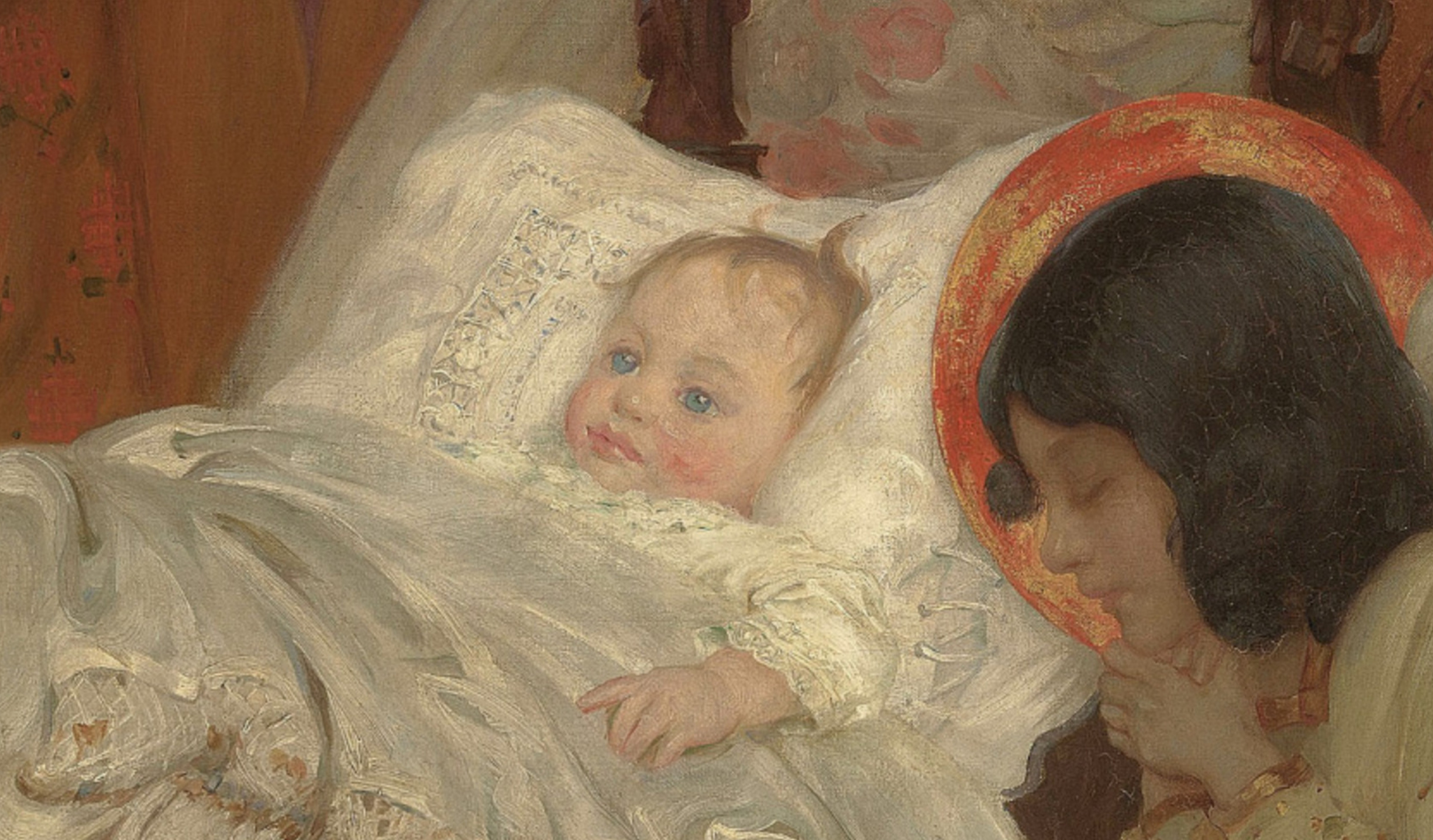
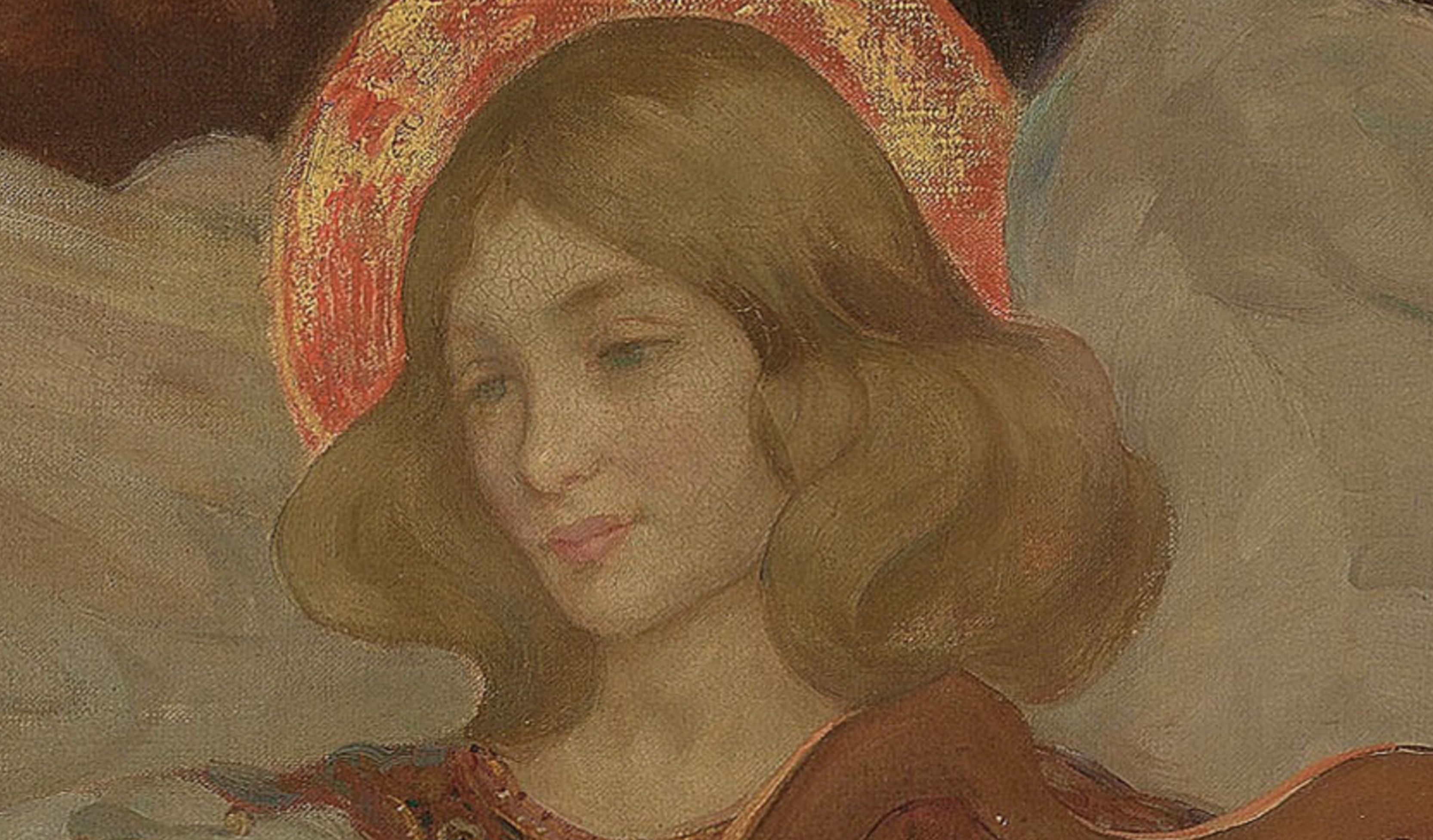
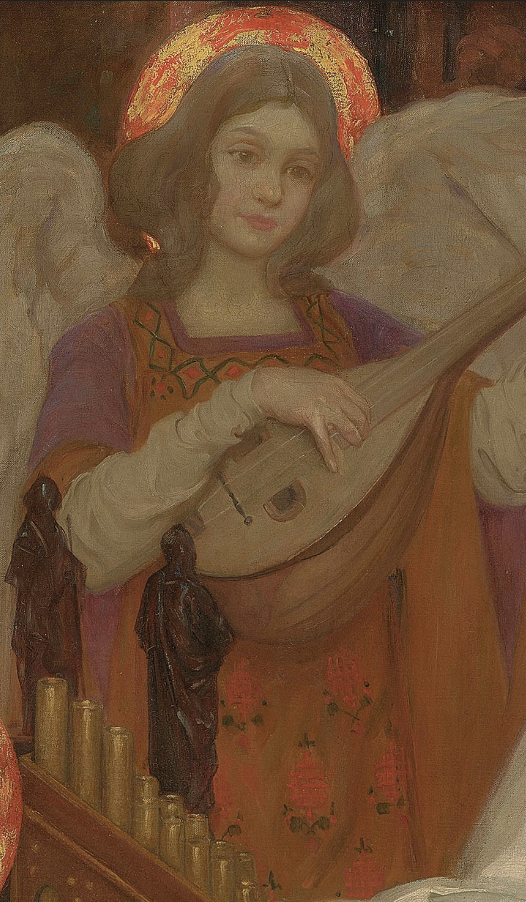


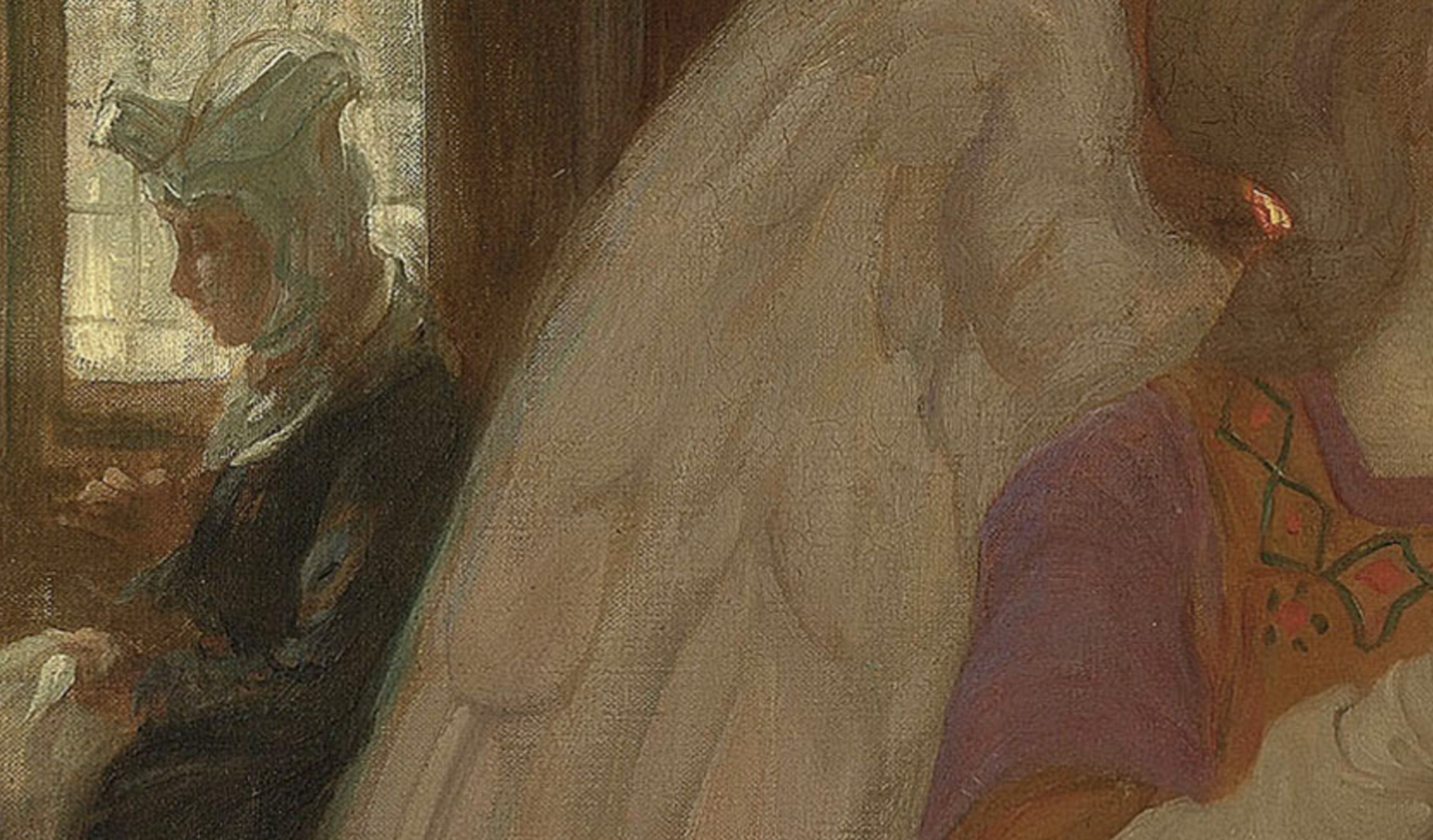

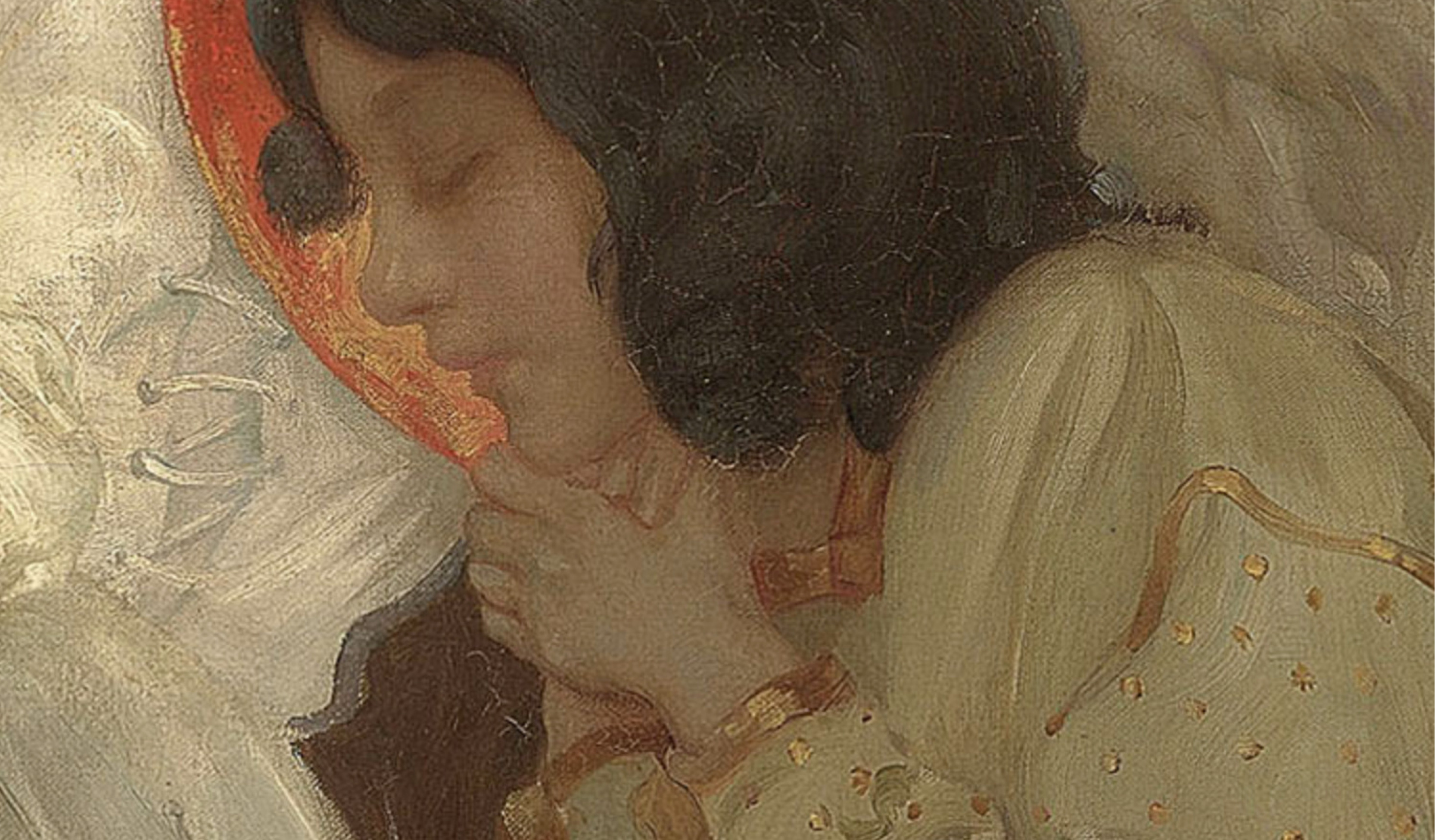
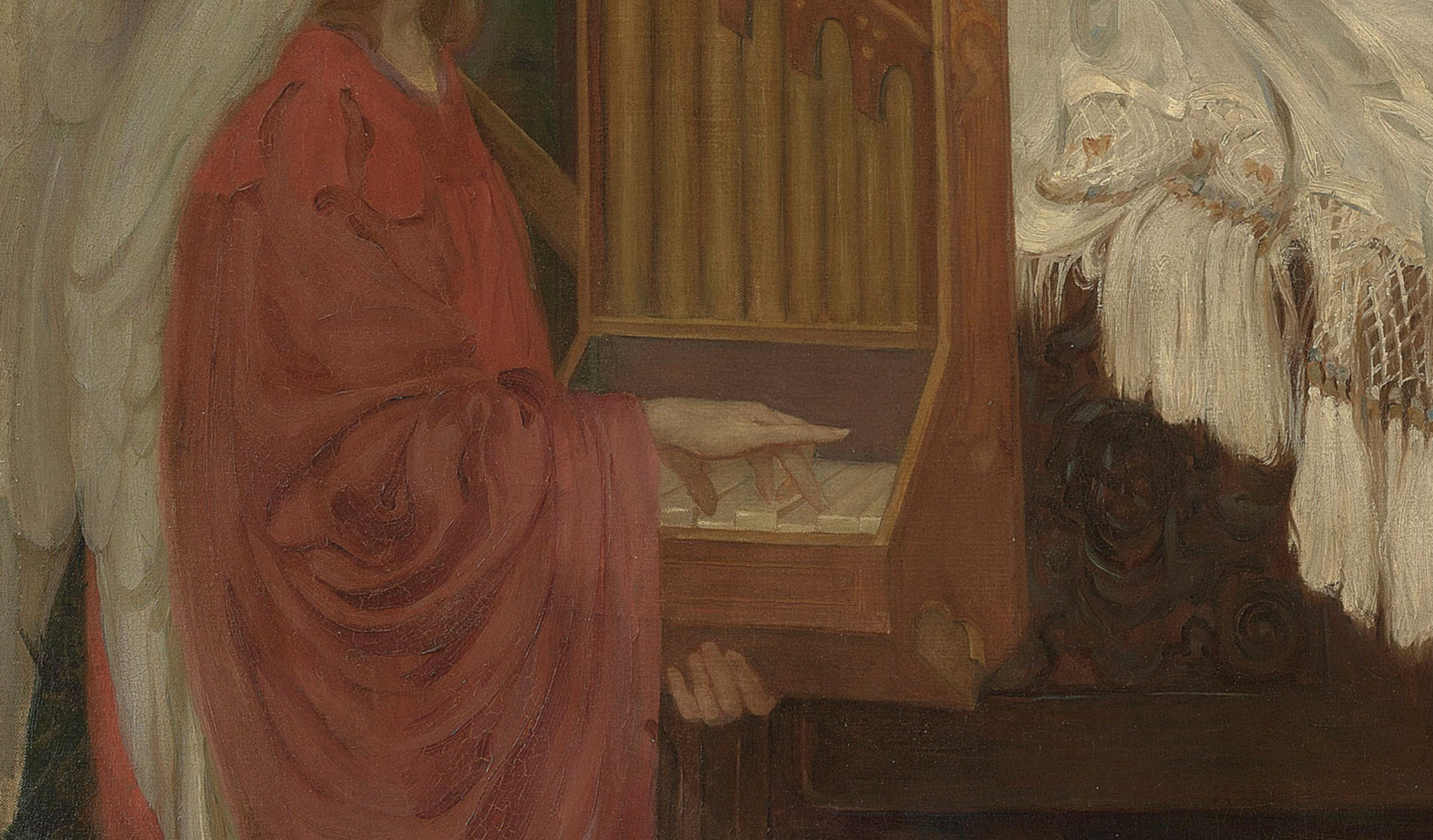




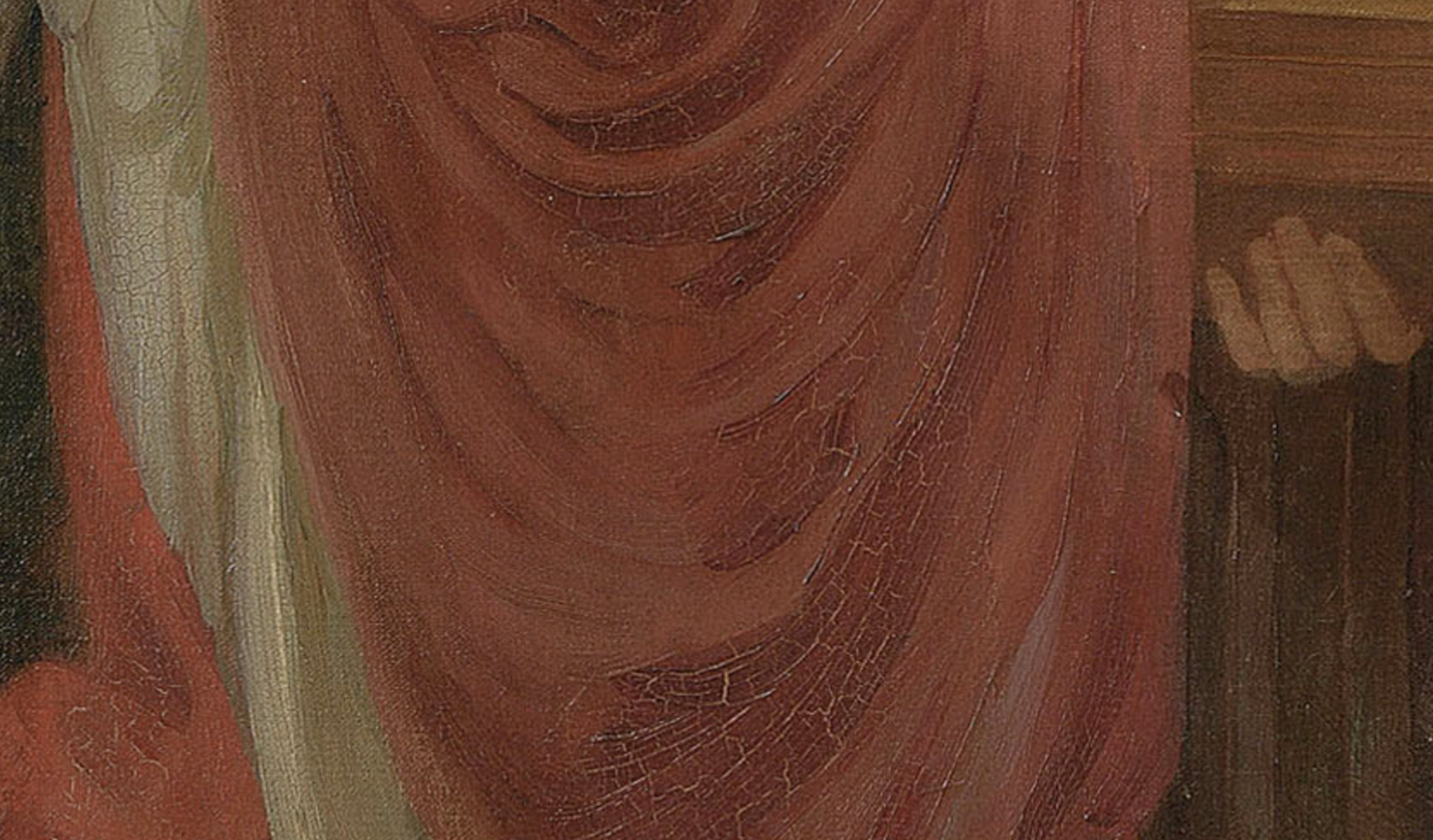

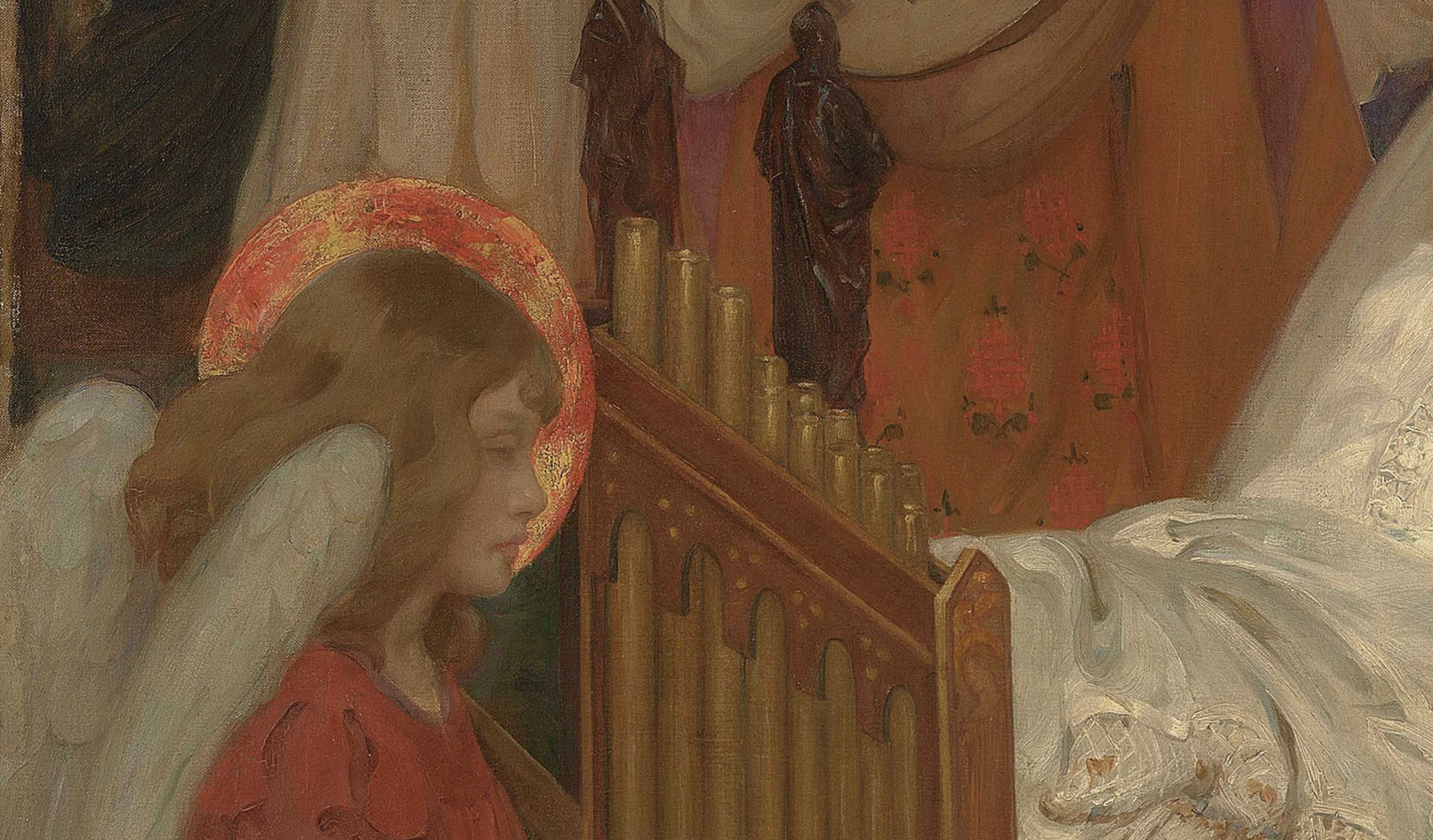
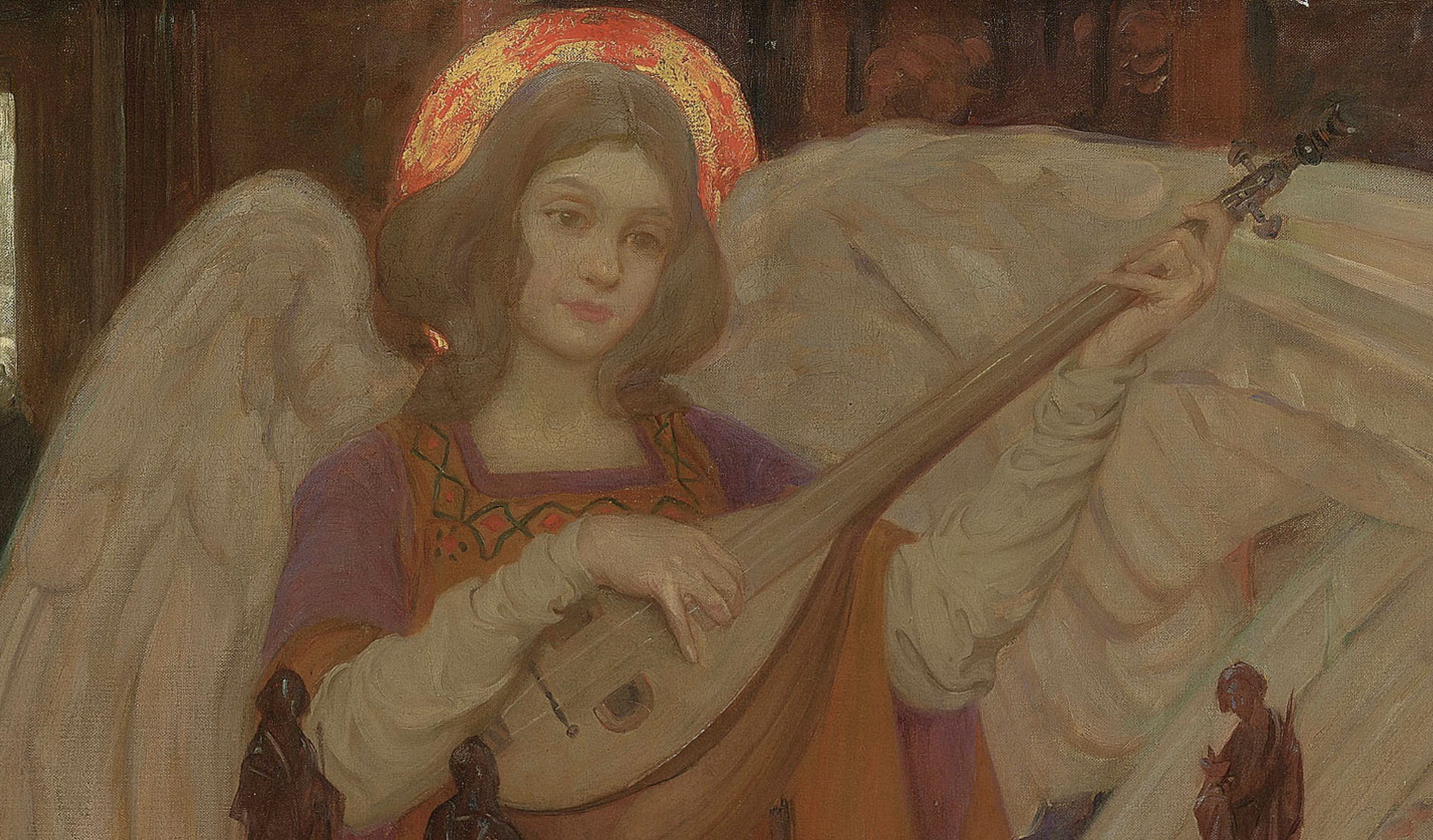

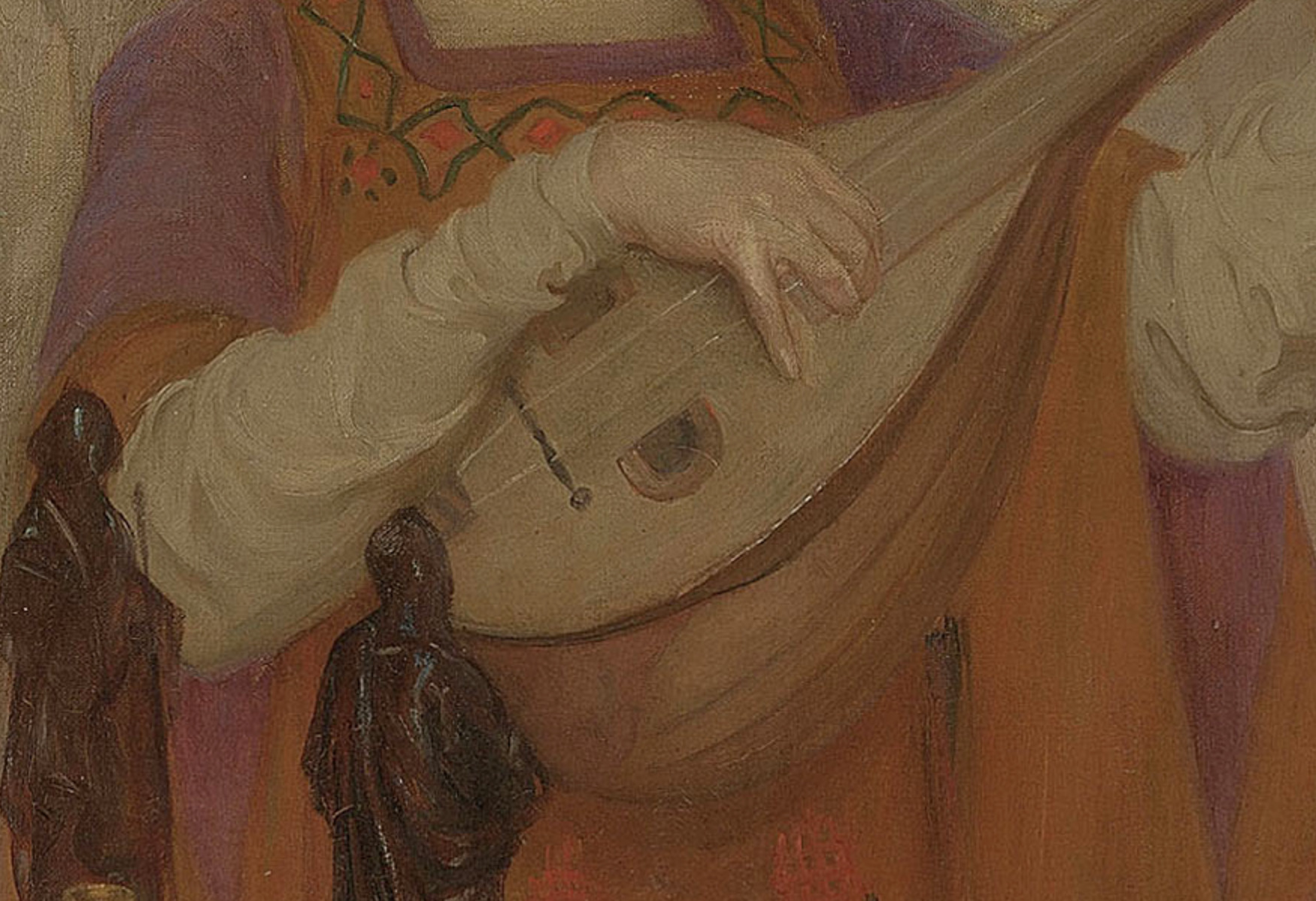
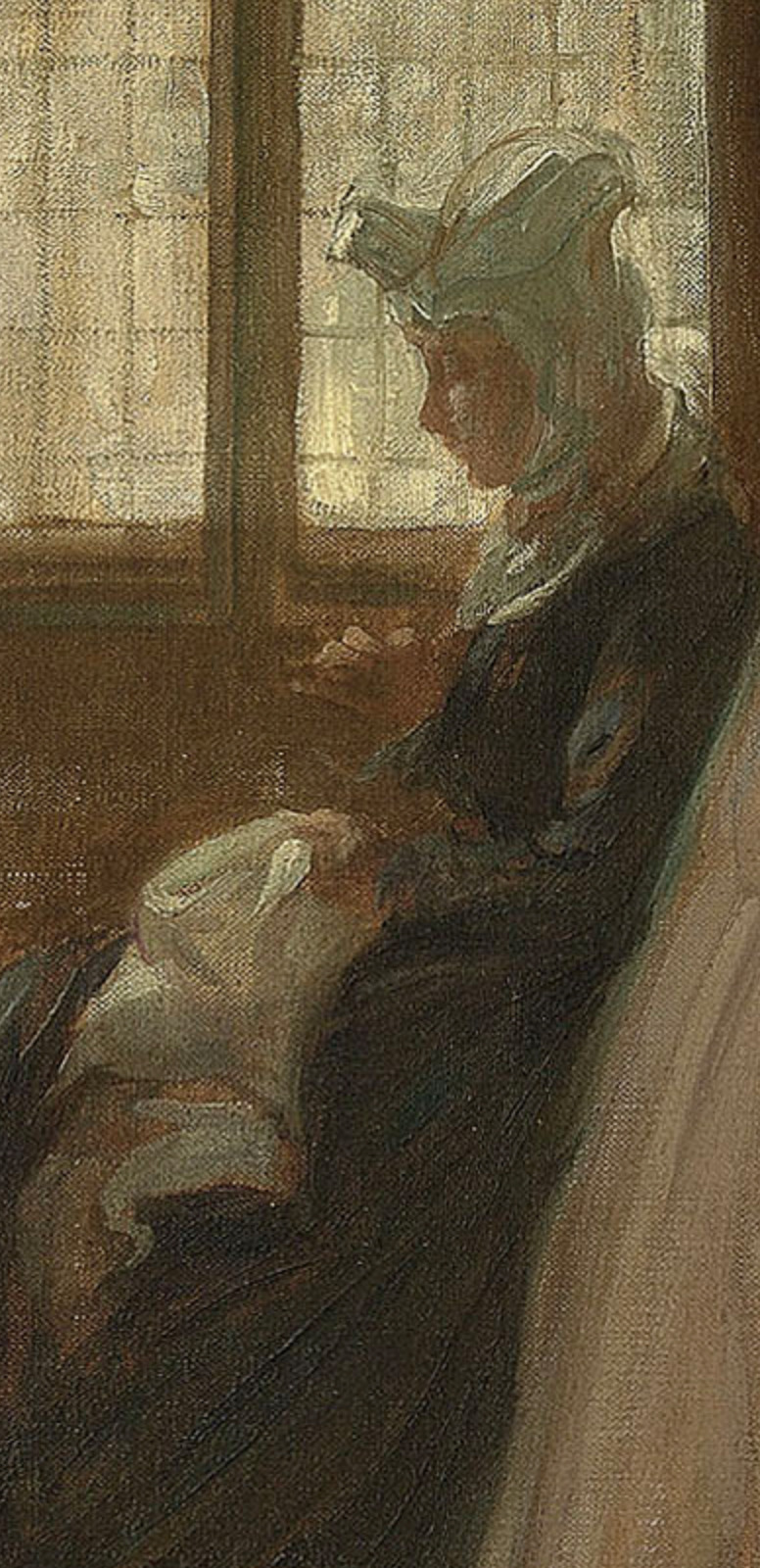

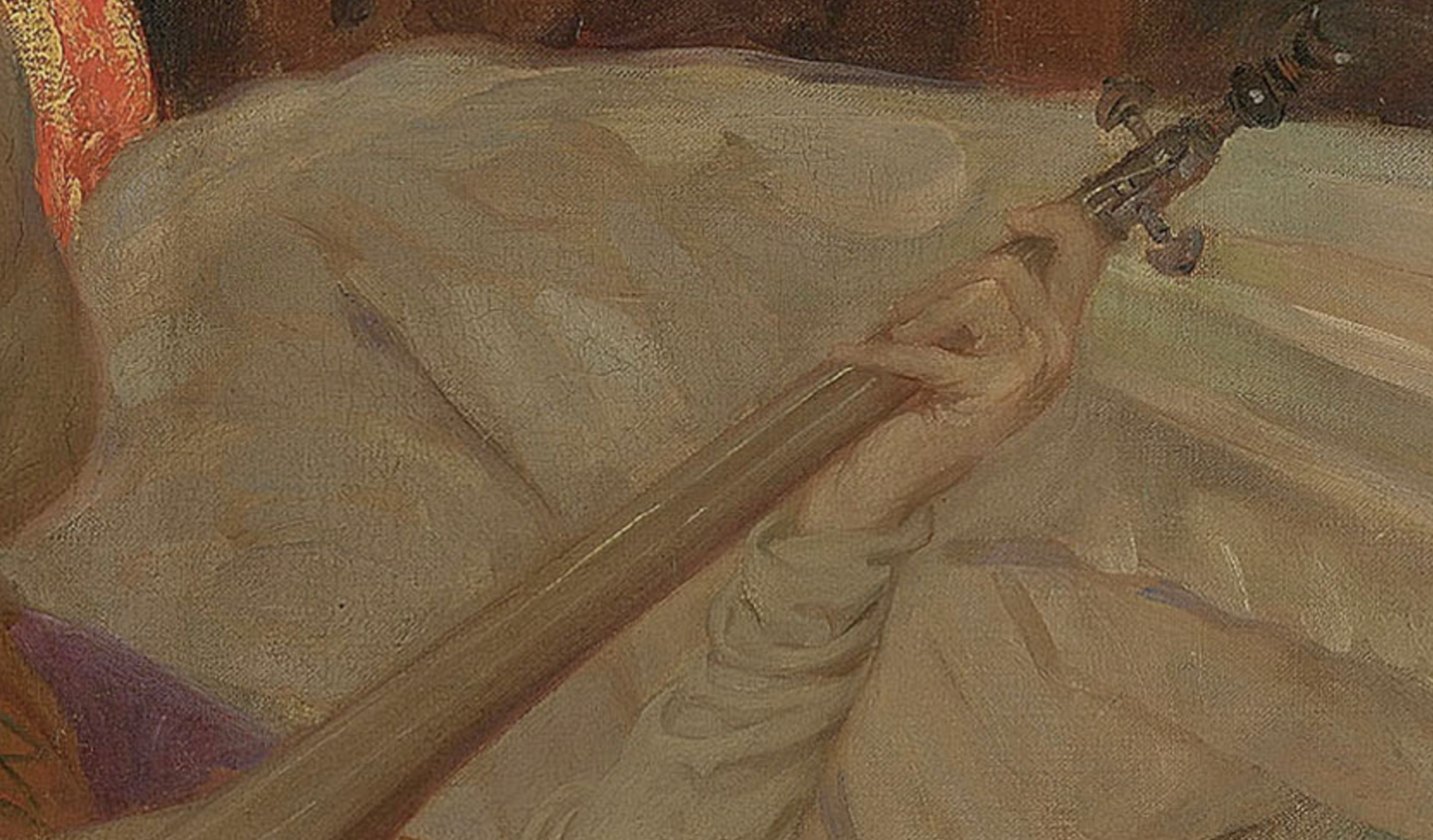
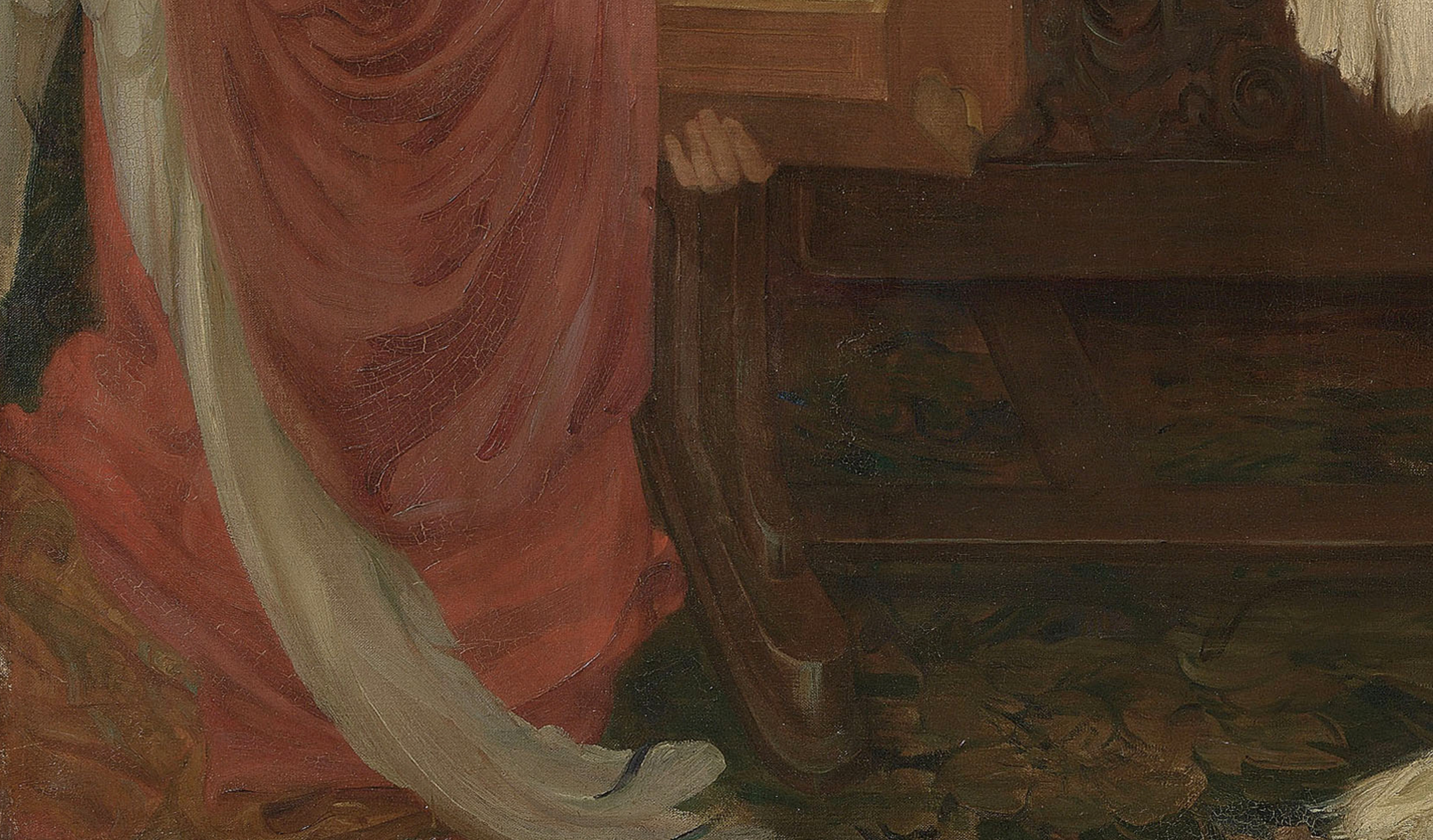
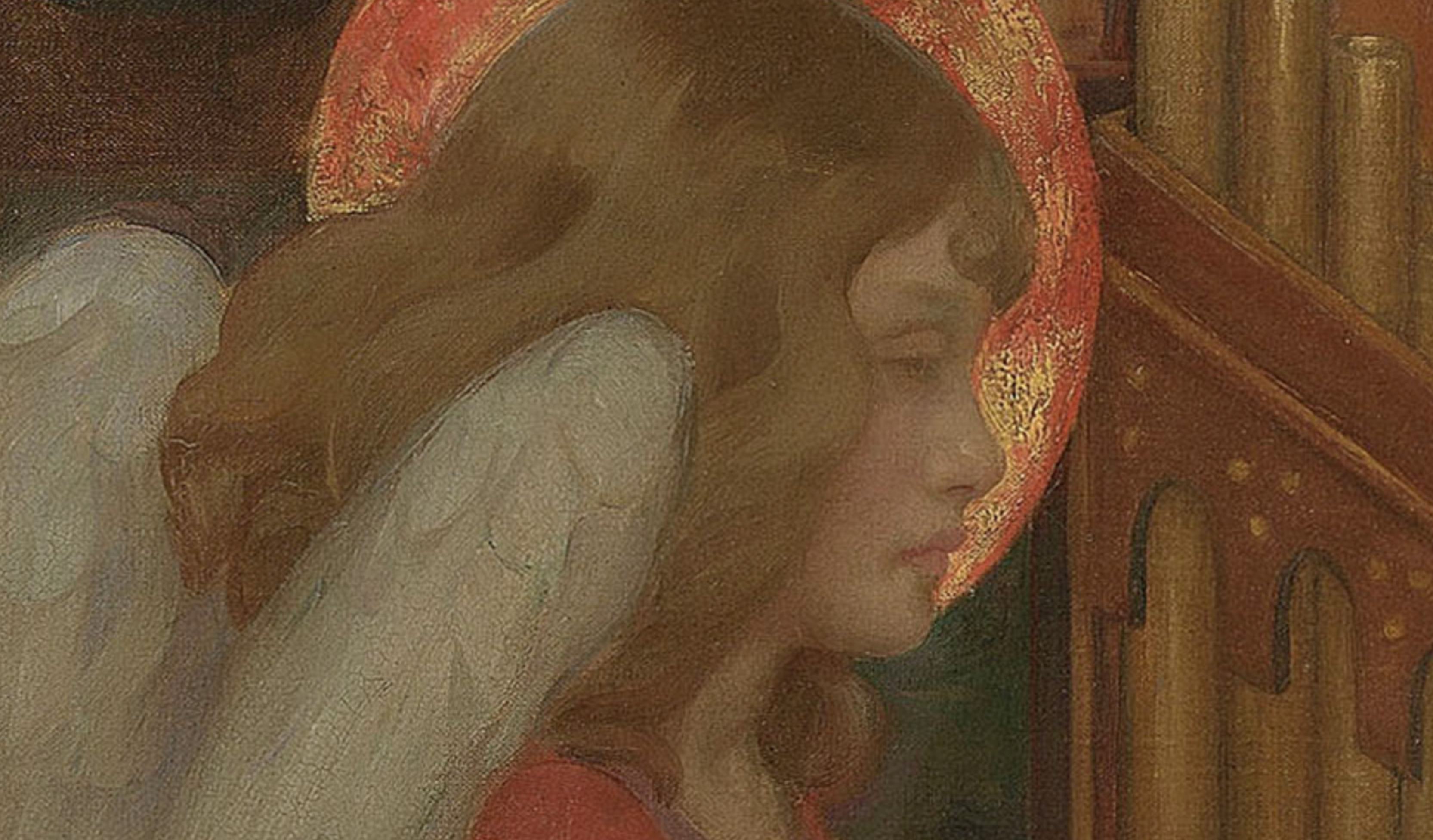
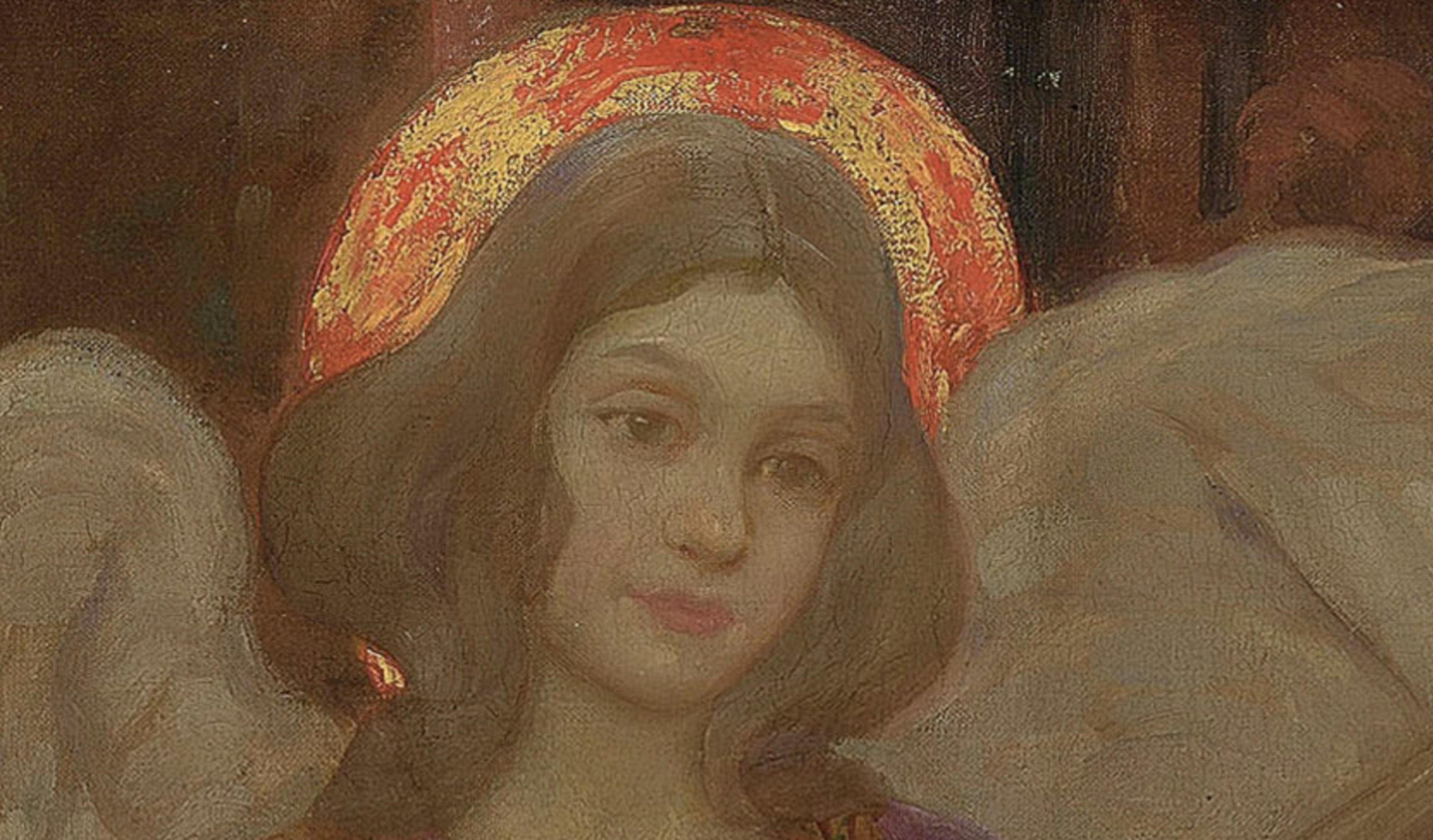
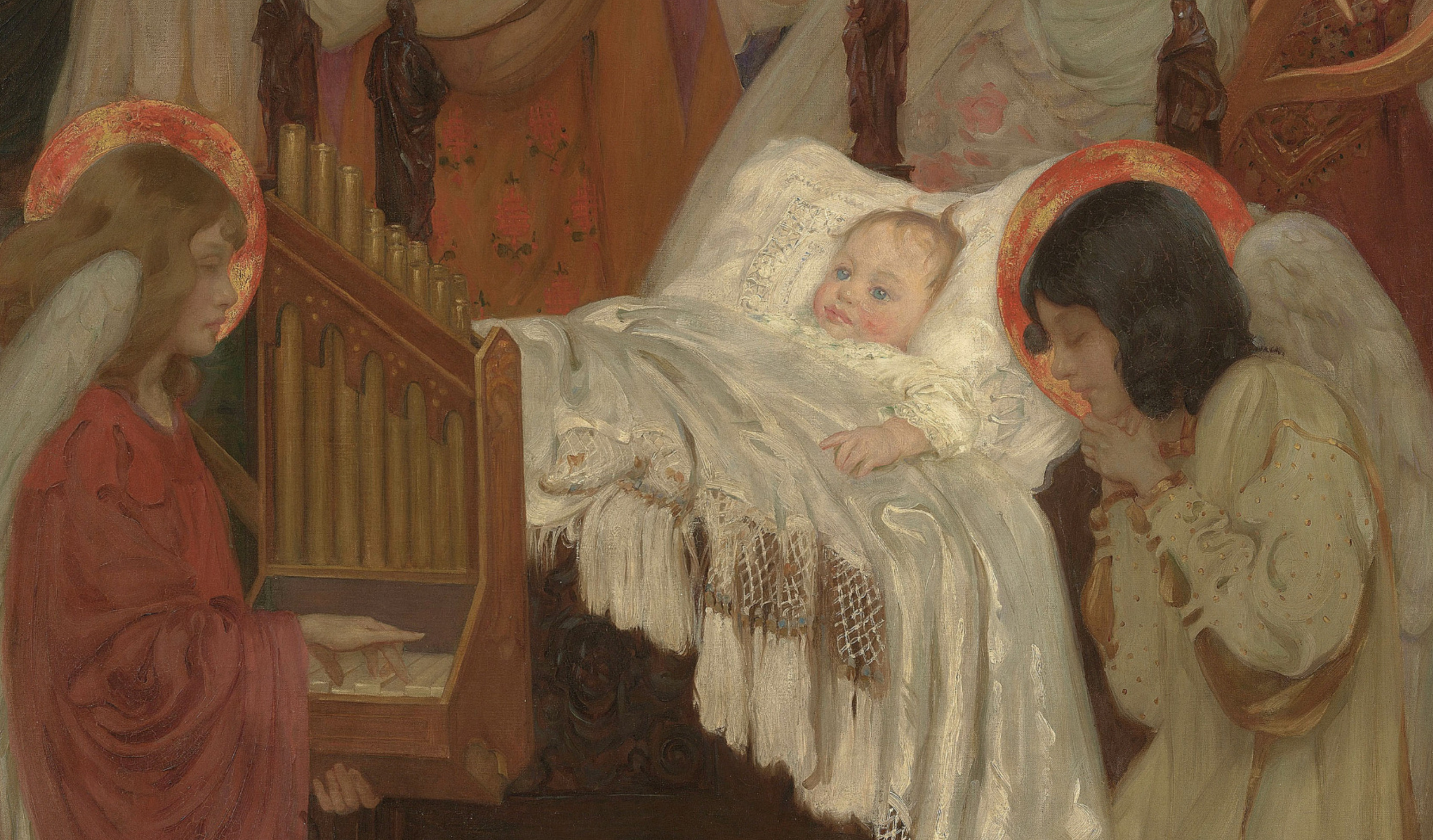
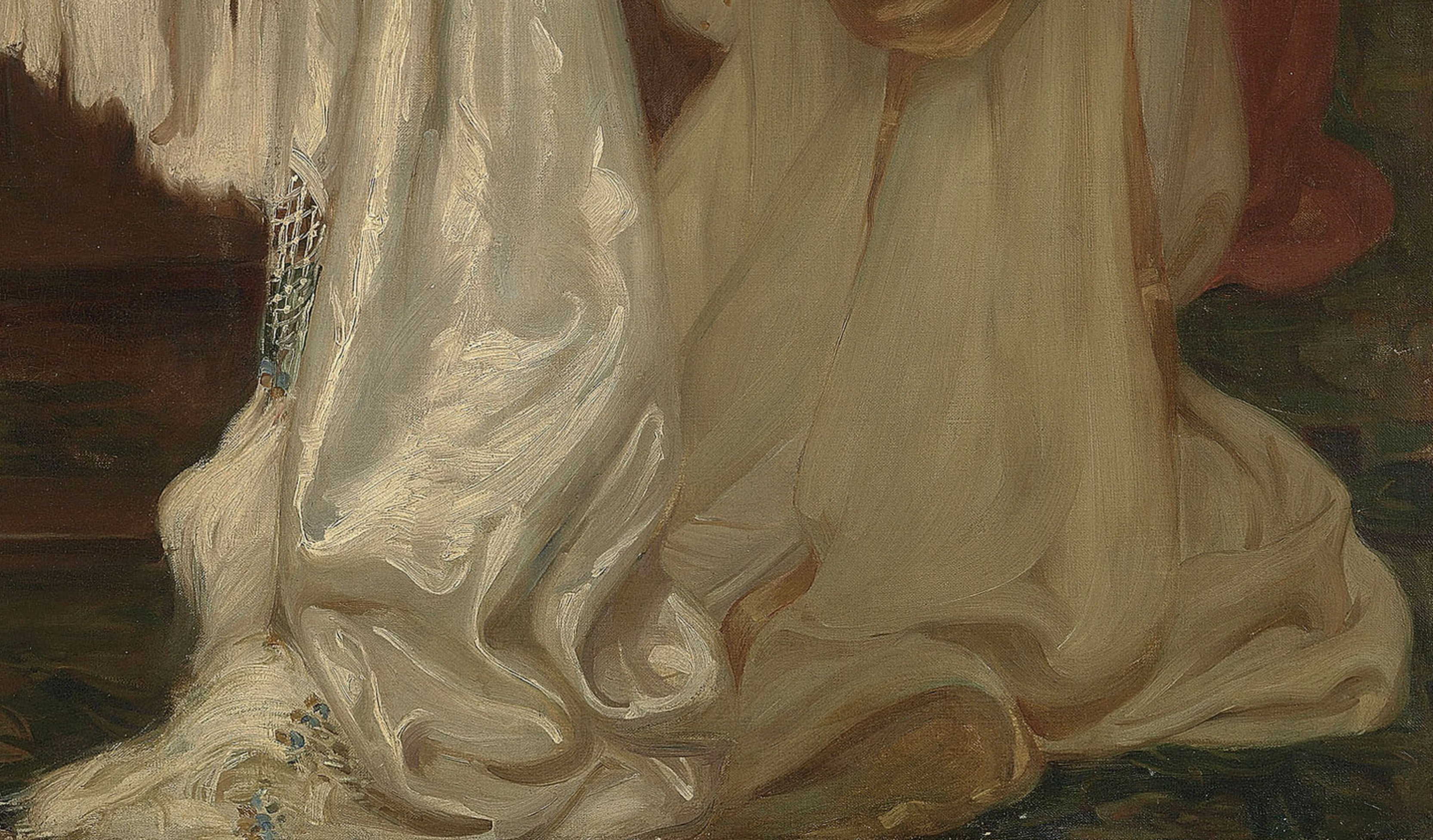
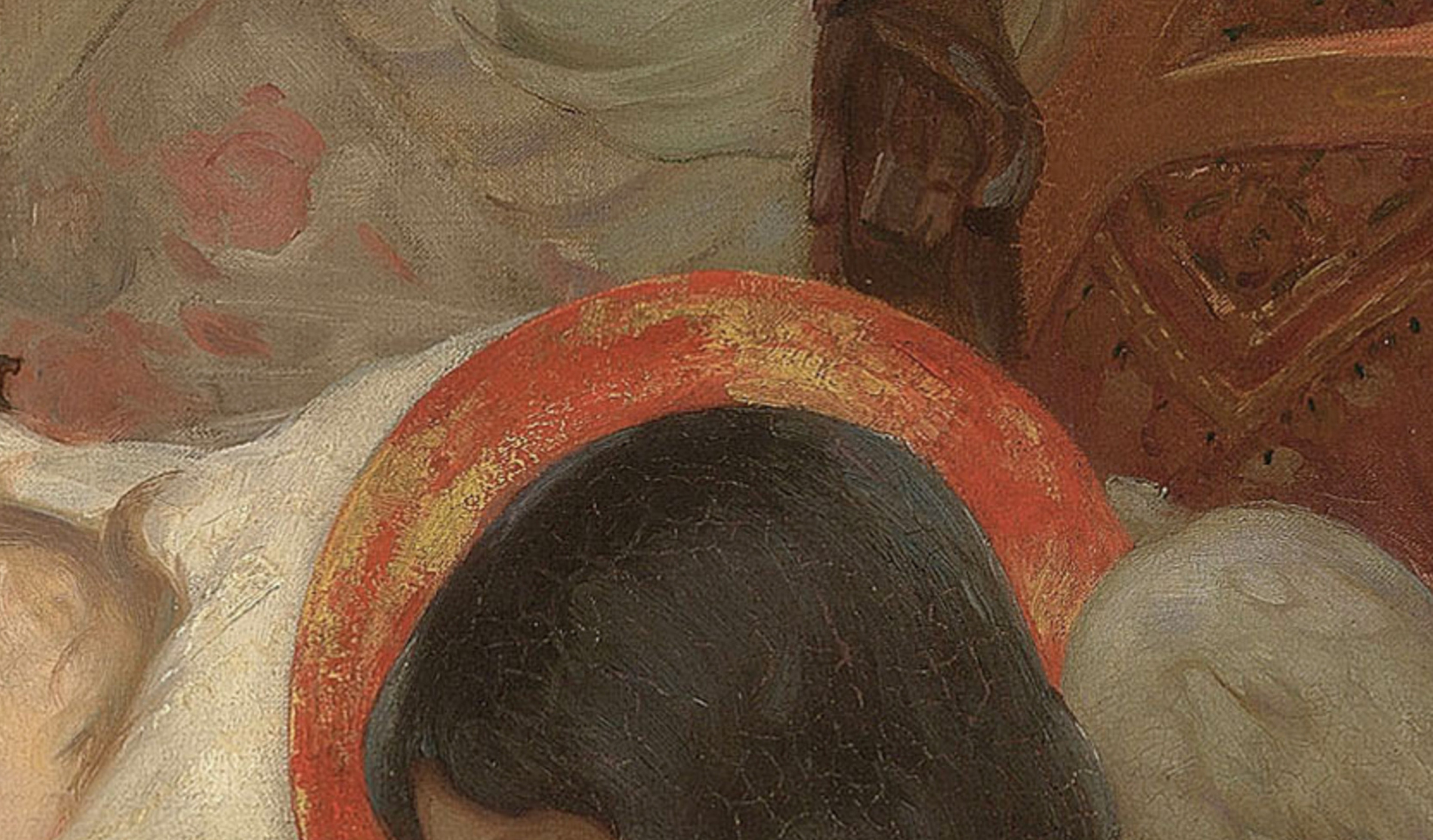
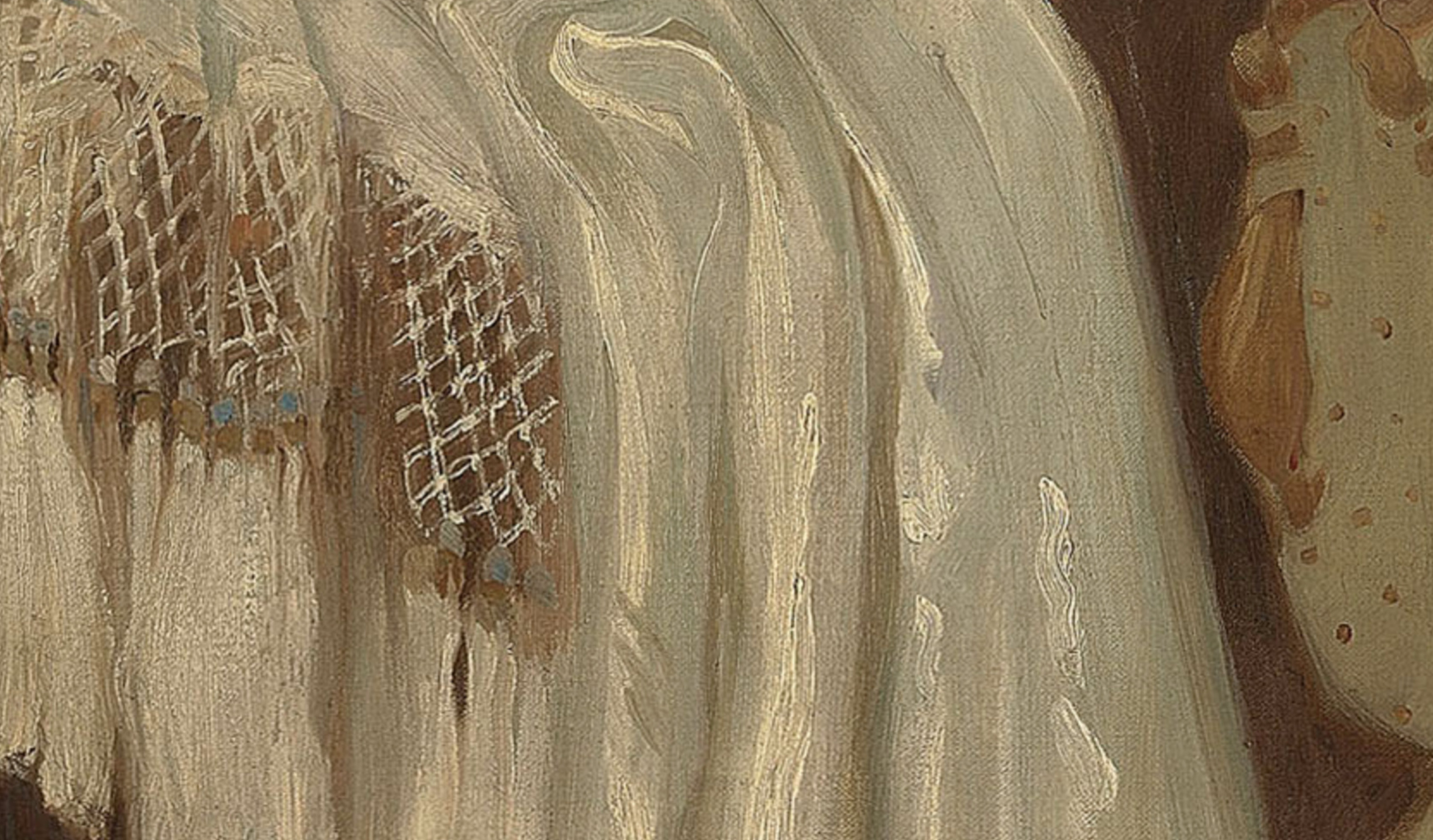
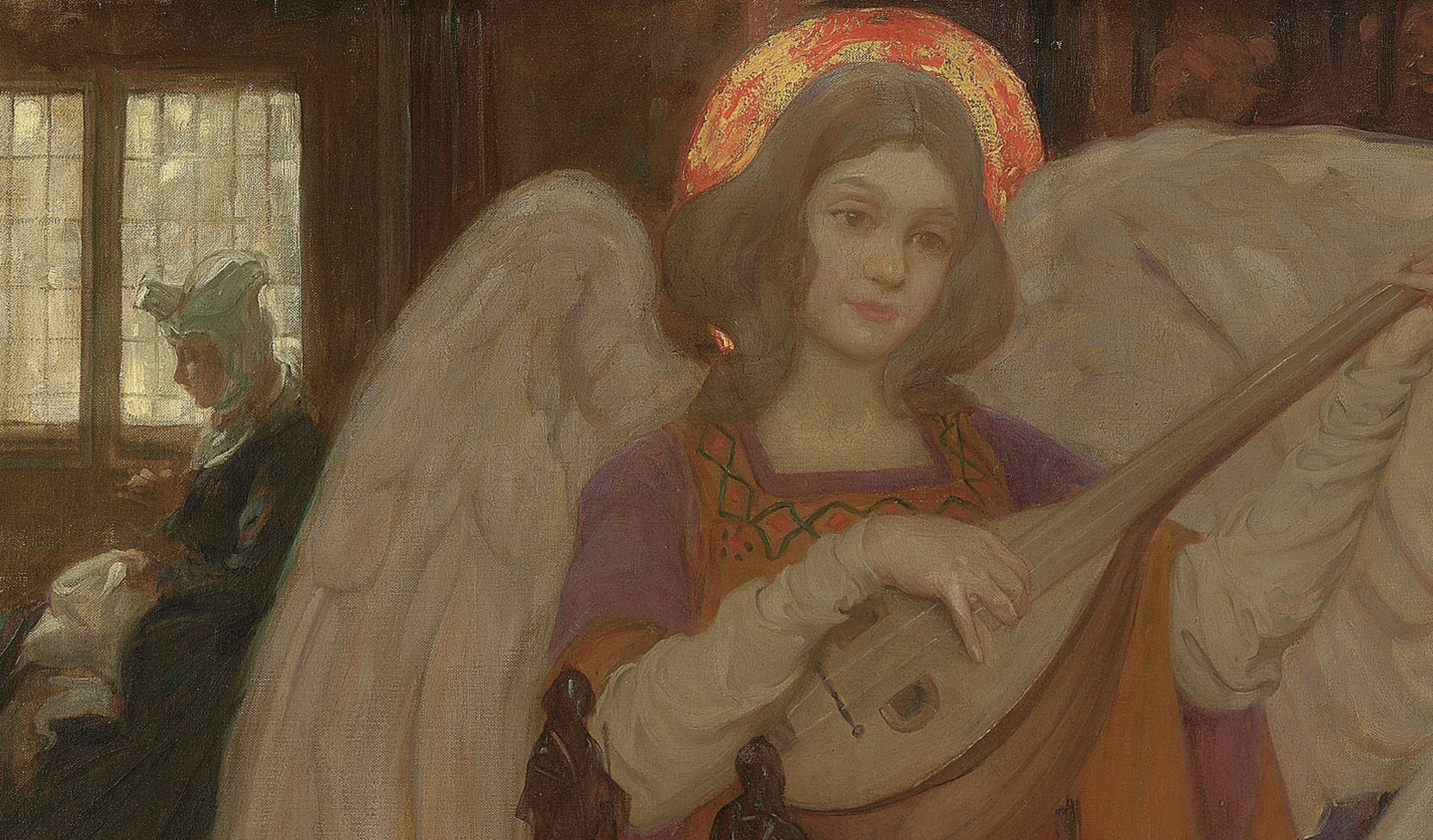
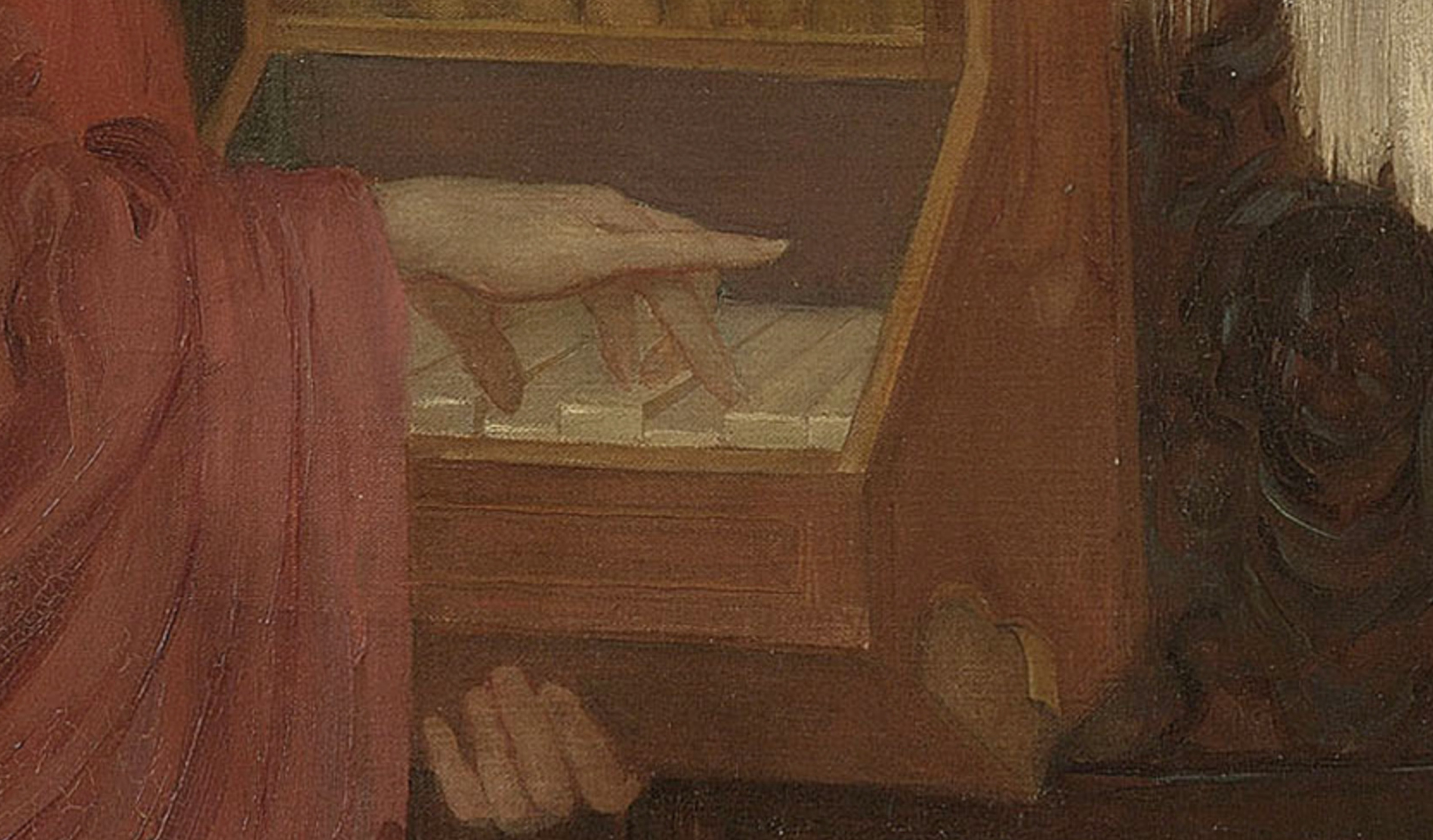

Details:
- Isobel Lilian Gloag, R.O.I., N.W.S. (1865-1917)
- British
- Four corners to my bed
- signed and inscribed ‘Four corners to my bed/Four angels round my head/Matthew, Mark, Luke & John/Bless the bed that I lie on./IL Gloag/4 Carlyle Studios/96 Kings…’ (on the artist’s label attached to the reverse)
- oil on canvas
- 54 ¼ x 54 ½ in. (137.8 x 138.5 cm.)
- Source: Christie’s
Sources
James Greig (1902), “Isobel Lilian Gloag and Her Work“, The Magazine of Art, Volume 26 pp. 289–293, edited by Marion Harry Spielmann, https://books.google.com/ , (accessed 29 Nov 2018).
Wikipedia contributors, “Isobel Lilian Gloag,” Wikipedia, The Free Encyclopedia, https://en.wikipedia.org/w/index.php?title=Isobel_Lilian_Gloag&oldid=868810163 (accessed December 1, 2018).
More Information
Read about Aestheticism and women artists:
- Nunn, Pamela Gerrish (2011). “Alienation, Adoption or Adaptation? Aestheticist Paintings by Women”. Cahiers victoriens et édouardiens (74): 141–154. doi:10.4000/cve.1364.
Read about Aestheticism at wikipedia.
Thanks for Visiting 🙂
~Sunnyside
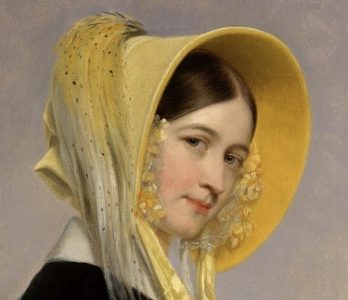
Beautiful and excellent research.
LikeLiked by 3 people
Thank you – I appreciate your visit and your kind words. 🙂
LikeLike
Love her work. She was quite an accomplished artist.
I can understand your determination to find our the cause of her death. I’m weird that way, too 🙂
The biographies I found online all state that she suffered from health problems throughout her life. One biography mentioned that she died childless. Was her featured painting a longing to have a child of her own?
During the period that Gloag lived (1865-1917), people died in large numbers from tuberculosis and bronchopneumonia. In 1915, according to the British Office for National Statistics, eight percent of women between 50 and 54 years died from valvular heart disease. [www.ons.gov.uk/peoplepopulationandcommunity/birthsdeathsandmarriages/deaths/articles/causesofdeathover100years/2017-09-18]
I think she most likely suffered from tuberculosis as did Robert Louis Stevenson (1850-1894).
LikeLiked by 2 people
I greatly appreciate your thoughts, Rosaliene! Weird is good. 😎. You have added much information to her story, and I did not know she died childless. Now I have more questions than ever. Have a lovely weekend, Rosaliene. Many thanks! 🙂
LikeLiked by 1 person
My pleasure 🙂
LikeLiked by 2 people
Beautifully expressed research and layout on Isobel Lilian Gloag. Wonderful work
LikeLiked by 2 people
I appreciate your visit, Yonnie. Thank you for such kind encouragement. 🙂
LikeLiked by 1 person
The pleasure is all mine! 🙏💜
LikeLiked by 2 people
You have wonderfully brought to life a truly talented and creative woman. Thank you for sharing.🙏🙏
LikeLiked by 2 people
She is definitely amazing! ❤️ I truly appreciate your kind words, Mr. Mel. 😎
LikeLike
This artist is new to me. Unfortunately, many female artists do not receive the recognition they deserve.
LikeLiked by 2 people
Hi Anna – this was my first time reading about her, too – now I want to know more. Thanks for commenting! 🙂
LikeLiked by 1 person
Ms. Gloag wouldn’t be considered a colorist by today’s standards since there are no neon colors in her painting. These days “colorists” use paint straight out of the tube because they never learned to mix colors This would look dull compared to the primitive ‘colorists” of today. A juror today would call this “muddy” because modern jurors don’t like monochromatic paintings, and they especially dislike brown. To me, this looks sophisticated.
The baby is the only person in the painting who is illuminated. And the baby is on satin sheets which probably means that even though the mother is distant and only a small shadowy figure, the baby has the material things of a privileged life. When the mother isn’t watching angels have to watch because the baby is blessed. The baby is awake but not trying to get the mother’s attention, maybe because the mother is always busy and won’t pick up the baby even if the baby did cry. Its up to angels to amuse the baby with music.
That’s my guess for the meaning but every art viewer puts their own interpretation on a painting. I don’t really know what Ms. Gloag meant to say.
LikeLiked by 2 people
Very interesting perspective, as always! Thanks for sharing your thoughts, Chris. 🙂
LikeLiked by 1 person
I meant to say, the baby can hear the music but not see the angels. Thanks for letting me put in my two cents!
LikeLiked by 2 people
You always make me think. I love that! 🙂
LikeLiked by 1 person
That’s mutual!!
LikeLiked by 2 people
You more than made up for yesterday!! When you come back, you do it with a BAM! I had never heard of this rhyme before or even this artist at all. Thank you, Sunside, for introducing me to both!!
LikeLiked by 2 people
This is the only painting by this artist I have studied so far, but I would like to learn more. Thanks for visiting, Susan. 🙂
LikeLiked by 1 person
You are welcome. It’s always a pleasure and a bright start in my day!
LikeLiked by 2 people
😎❤️🙏
LikeLiked by 1 person
So peaceful. Thank you.
LikeLiked by 2 people
I appreciate your visit! 🙂
LikeLike